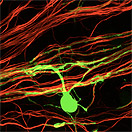News
Study shows how social isolation
disrupts myelin production
-
 Print
Print -
 Comments
(2)
Comments
(2)
-
Researchers have found that social isolation disrupts the process of myelination of the brain’s axons (in red) by oligodendrocytes (in green). Click on the image to see a larger version.
Animals that are socially isolated for prolonged periods make less myelin in the region of the brain responsible for complex emotional and cognitive behavior, researchers at UB and Mt. Sinai School of Medicine report in Nature Neuroscience online.
The research sheds new light on brain plasticity, the brain’s ability to adapt to environmental changes. It reveals that neurons aren’t the only brain structures that undergo changes in response to an individual’s environment and experience, according to one of the paper’s lead authors, Karen Dietz, research scientist in the Department of Pharmacology and Toxicology, UB School of Medicine and Biomedical Sciences.
Dietz did the work while a postdoctoral researcher at Mt. Sinai School of Medicine; Jia Liu, a Mt. Sinai postdoctoral researcher, is the other lead author.
The paper notes that changes in the brain’s white matter, or myelin, have been seen before in psychiatric disorders, and demyelinating disorders also have had an association with depression. Recently, myelin changes also were seen in very young animals or adolescents responding to environmental changes.
“This research reveals for the first time a role for myelin in adult psychiatric disorders,” Dietz says. “It demonstrates that plasticity in the brain is not restricted to neurons, but actively occurs in glial cells, such as the oligodendrocytes, which produce myelin.”
Myelin is the crucial fatty material that wraps the axons of neurons and allows them to signal effectively. Normal nerve function is lost in demyelinating disorders, such as multiple sclerosis and the rare, fatal, childhood disease Krabbe’s disease.
This paper reveals that the stress of social isolation disrupts the sequence in which the myelin-making cells, the oligodendrocytes, are formed.
In the experiment, adult mice, normally social animals, were isolated for eight weeks to induce a depressive-like state. They then were introduced to a “novel” mouse, one they hadn’t seen before; while mice normally are highly motivated to be social, those who had been socially isolated did not show any interest in interacting with the new mouse, a model of social avoidance and withdrawal.
Brain tissue analysis of the socially isolated animals revealed significantly lower-than-normal levels of gene transcription for oligodendrocyte cells in the prefrontal cortex, a region of the brain responsible for emotional and cognitive behavior.
“This research provides the first explanation of the mechanism behind how this brain plasticity occurs,” says Dietz, “showing how this change in the level of social interaction of the adult animal resulted in changes in oligodendrocytes.”
The key change was that cellular nuclei in the prefrontal cortex contained less heterochromatin, a tightly packed form of DNA material, which is unavailable for gene expression.
“This process of DNA compaction is what signifies that the oligodendrocytes have matured, allowing them to produce normal amounts of myelin,” says Dietz. “We have observed in socially isolated animals that there isn’t as much compaction and the oligodendrocytes look more immature. As adults age, normally, you would see more compaction, but when social isolation interferes, there’s less compaction and therefore, less myelin being made.”
She adds, however, that the research also showed that myelin production went back to normal after a period of social integration, suggesting that environmental intervention was sufficient to reverse the negative consequences of adult social isolation.
The new paper, together with a report published earlier this year by another group showing myelin changes triggered by social isolation early in life, will broaden investigations into brain plasticity, says David Dietz, UB assistant professor of pharmacology and toxicology, and one of the paper’s co-authors,
In addition, notes Karen Dietz, the work has implications for future questions regarding MS and other myelin disorders. “This research suggests that maybe recovery from an MS episode might be enhanced by social interaction,” she says. “This opens another avenue of investigation of how mood and myelin disorders may interact with one another.”
Major funding for the research came from the National Institutes of Health.


Reader Comments
Mary Kohler says:
I would be curious to see how or if this research can be applied in addressing the effects of isolation due to homelessness or bullying.
Posted by Mary Kohler, Homelessness and Bullying?, 12/05/12
Kerrie Martin says:
This is some mind-blowingly interesting & truly useful research. I can't WAIT to see all the ways this knowledge is applied!
Posted by Kerrie Martin, Alumna, 11/15/12